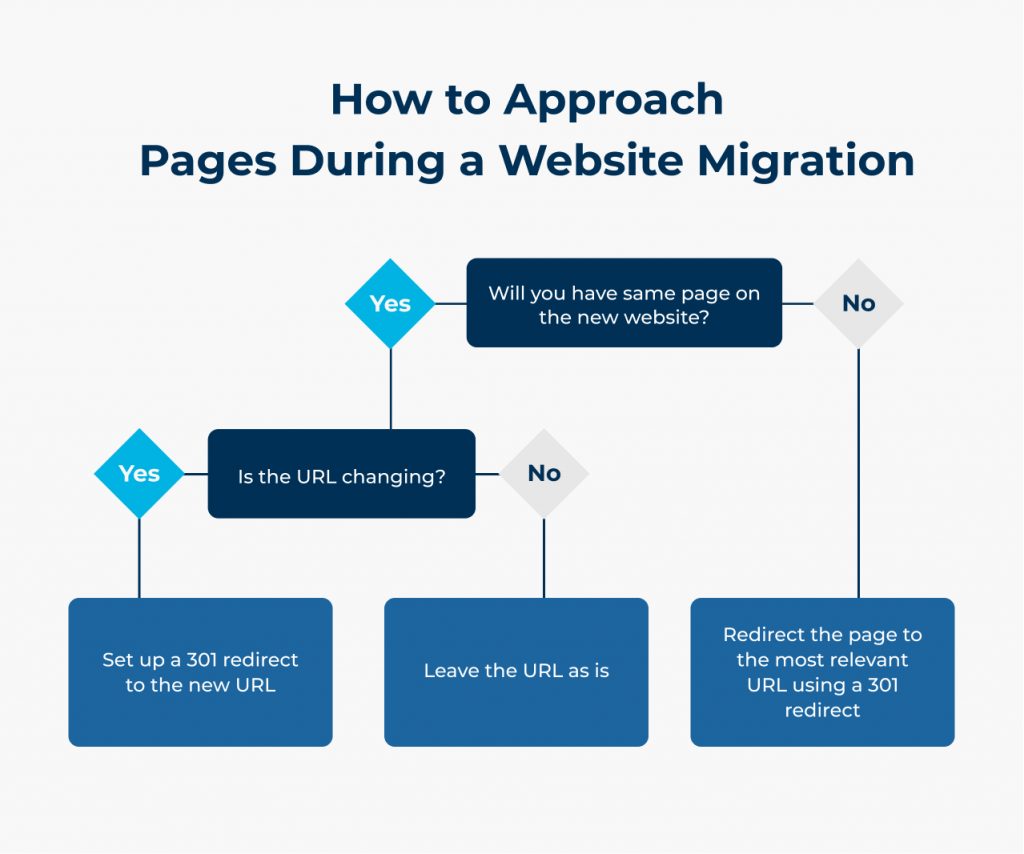
Considering a Website Migration? Don’t Make These Mistakes
Considering a Website Migration? Don’t Make These Mistakes
No matter how good your website is, at some point, you might need to go through a migration. For example, you’re rebranding or your business has expanded and your current website doesn’t reflect it.
Migrations are scary. But if everything is done correctly and all the departments – SEO, development, content – are in sync, your traffic should not suffer.
I’ve worked on many website migrations. I’ve distilled all my experience to share it with you in this post. After reading it, you will understand what you should avoid at all costs. This will help you to go through a website migration successfully.

But First, Let’s Look into the Types of Migrations
- A simple domain change. All the internal URLs stay the same. It’s the easiest type of migration that Google can pick up really quickly.
- Example: site.com/our-product.html -> newsite.com/our-product.html
- A more complex migration when the internal URLs change. The domain might change or stay the same. It takes Google much longer to re-evaluate all the changes.
- Example: site.com/our-product.html -> newsite.com/product.html
- Or: site.com/our-product.html -> site.com/product.html
- A migration to a new content management system
- Example: HubSpot -> WordPress
- Other: redesign, change of the website structure

Why a Migration Can Hurt a Website
When your website has been there for a while, Google has a good understanding of its topic, structure and relevancy for different searches.
When you change something, Google (and other search engines) needs to re-evaluate your website considering that update. The bigger the change is, the longer this re-evaluation process might take.
If, for example, you remove a page that used to be popular, your traffic will tank. Such things happen a lot when you don’t have a clear migration process or somebody to take control of all the minor and major changes.

Avoid These Mistakes In Your Website Migration
Want peace of mind? Never ever ignore these don’ts!
Don’t redirect all old URLs to the homepage
Why
Each URL of your website has acquired signals over time, such as topical relevancy, authority, its place within your website hierarchy, etc. If you redirect it to the homepage, you’re losing all these signals. You basically throw away all the wins you’ve achieved till that point, which will prevent your SEO success. Don’t do that!
What you should do instead
Implement redirects on a page-by-page basis.
First of all, you need to have a list of all the URLs. You can get it in different ways but I usually prefer using a combination of them not to miss anything.
Use at least 2 sources:
- Your sitemap.xml (found at yourdomain.com/sitemap.xml)
- A crawl of your website (for example, from Screaming Frog)
- Google Analytics pages (under Behavior -> Site Content -> All Pages)
- Google Search Console pages (Performance -> Pages)
Take your URLs list and merge them together in a Google Sheet. Remove duplicates, this will help to go through the final list much faster.
Now you have a comprehensive list of all your pages. Use it to create a redirect map. The outcome is to have an action point for each URL in the list.
Here is an example of a redirect map I used for one of the projects I worked on:

- Old Page URL – a list of all the URLs on the current website
- Action – an action to take: redirect or leave the page
- Final URL – the URL that you should have on the new website after the migration. Depending on the ‘Action’, it will be either the same URL as in the first column or a different URL.
Pro tip:
Set up 301 redirects. Not 302, not JS redirects. 301s! They tell search engines: ‘This is a permanent redirect so you can carry all the signals from the old URL to the new URL right away!’.

Don’t ignore important pages while migrating
Why
You might have that old blog post which still drives traffic and leads. Don’t forget to transfer it to the new website.
Let me reiterate this: every single page has its place within your website. If you ignore a page during the migration, you will lose all the benefits it used to give you including traffic.
What you should do instead
This mistake will be illuminated if you do use the redirect sitemap approach from the previous point. Be sure to utilize every page and redirect every single thing appropriately to avoid wasted work.

Don’t change the URL structure unless it’s absolutely needed
Why
The simpler your migration is, the faster Google picks it up.
The more URL changes you have, the more complicated your migration is.
The bottom line: don’t slow down the process by changing URLs just for the sake of changing them.
What you should do instead
Leave the URLs as they are unless it’s not possible for a valid reason. It has happened so many times to me: a client wants to change the URLs as ‘they just look nicer this way’. This is not a valid reason.
Here are examples of valid reasons:
- You are changing a CMS and there’s no way to keep the old URL structure on a new platform
- Your current URL structure has too many subfolders (e.g. 3-5) and you want to simplify it
Pro tip:
Here’s a handy scheme that ties together all the 2 points I’ve already mentioned. It will help you understand how to treat each URL:


Don’t ignore SEO on the early stage of your migration project
I hear this so much: ‘I’ll first create a website, then I’ll do SEO’, ‘I’ll first migrate a website, then I’ll optimize it’. The logic behind this is broken. It’s like changing the roof of a house when the foundation is full of cracks: the roof will surely look great but will the house last for long?
You need to involve an SEO person before you have a full migration plan. They actually should take part in defining this plan. Then you’ll have the redirect map, the right URL structures, no forgotten pages and no major losses after the website migration.

More Website Migration Tips? Yes, Please
I put together the ‘must-do’ steps for pre-migration, during-migration and post-migration stages. You can use them as a checklist.
Pre-migration
- Clearly define why the migration is required and what is changing
- Put together a map of all the existing URLs and clear action for each of them (leave or redirect, plus the redirect target)
- Have a staging website ready. It will serve as a testing environment
During migration
- Test all the redirects on the staging website
- Update the internal linking to point to the new URLs
Post-migration
- Add an annotation in Google Analytics. This way you will easily see when the migration happened. It helps a lot in the long-term analysis and it frees your mind as you don’t have to remember all the key website changes.
- Test all the redirects again just in case. Double-checking never hurts!
- Make sure that the new pages are allowed to be crawled: check the robots.txt file.
- Make sure that the new pages are allowed to be indexed: check meta-robots tags, they should be set to ‘index, follow’.
- Watch closely your traffic in Google Analytics and in Google Search Console to spot any anomalies early.
Final Bricks
Now you know what to do, and most importantly – what not to do while migrating your website. If you complete all the steps correctly and have all the needed people on board, your website migration will go smoothly!
The views included in this article are entirely the work and thoughts of the author, and may not always reflect the views and opinions of Regex SEO.

